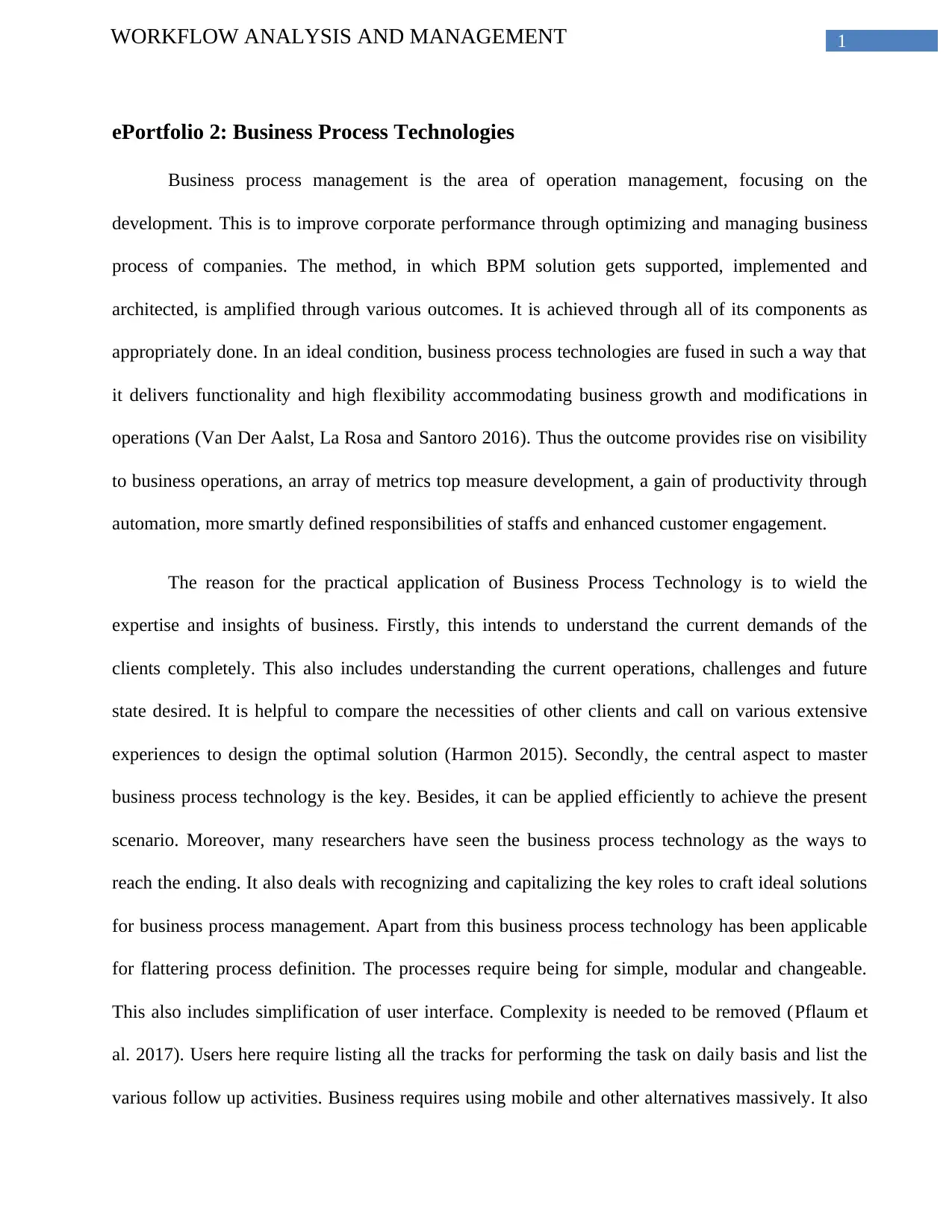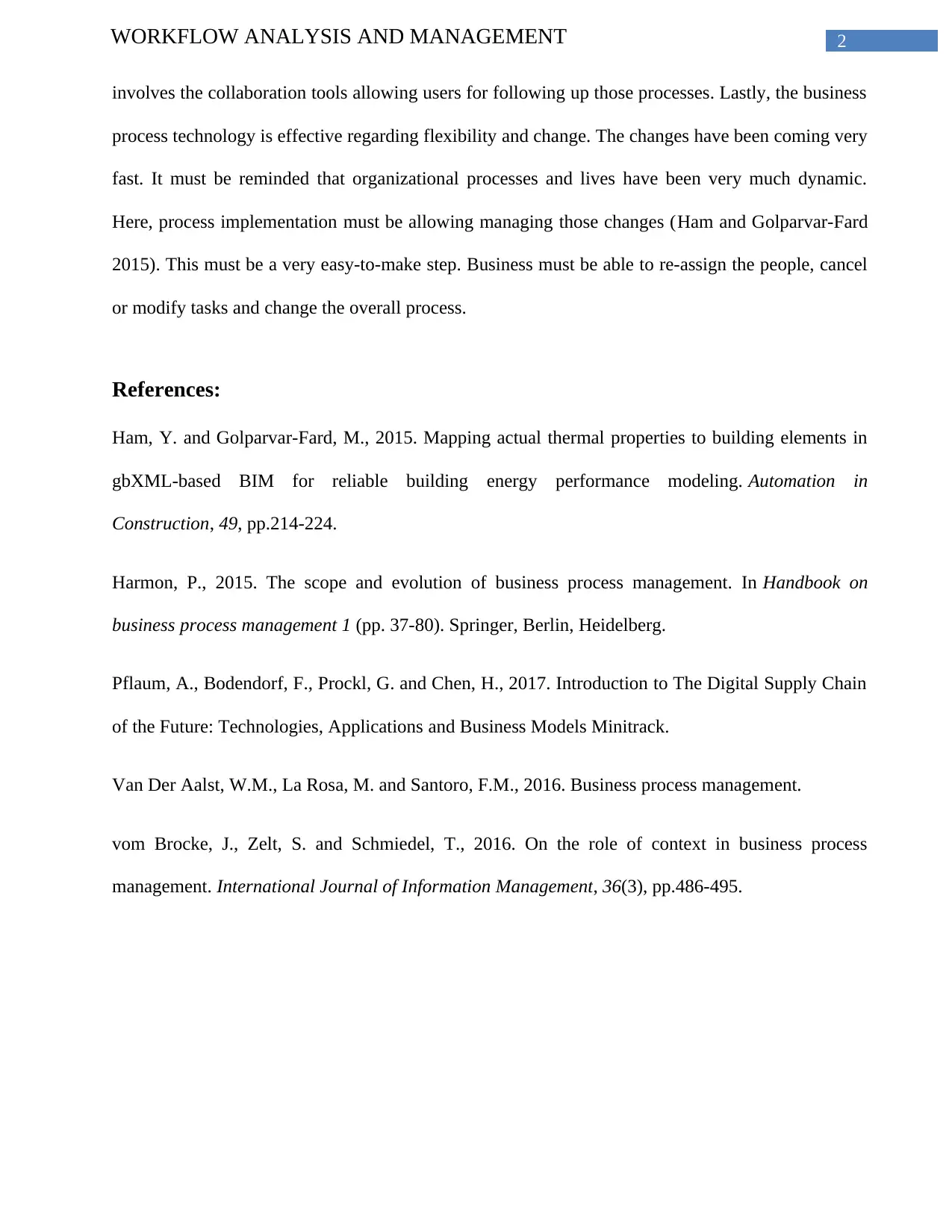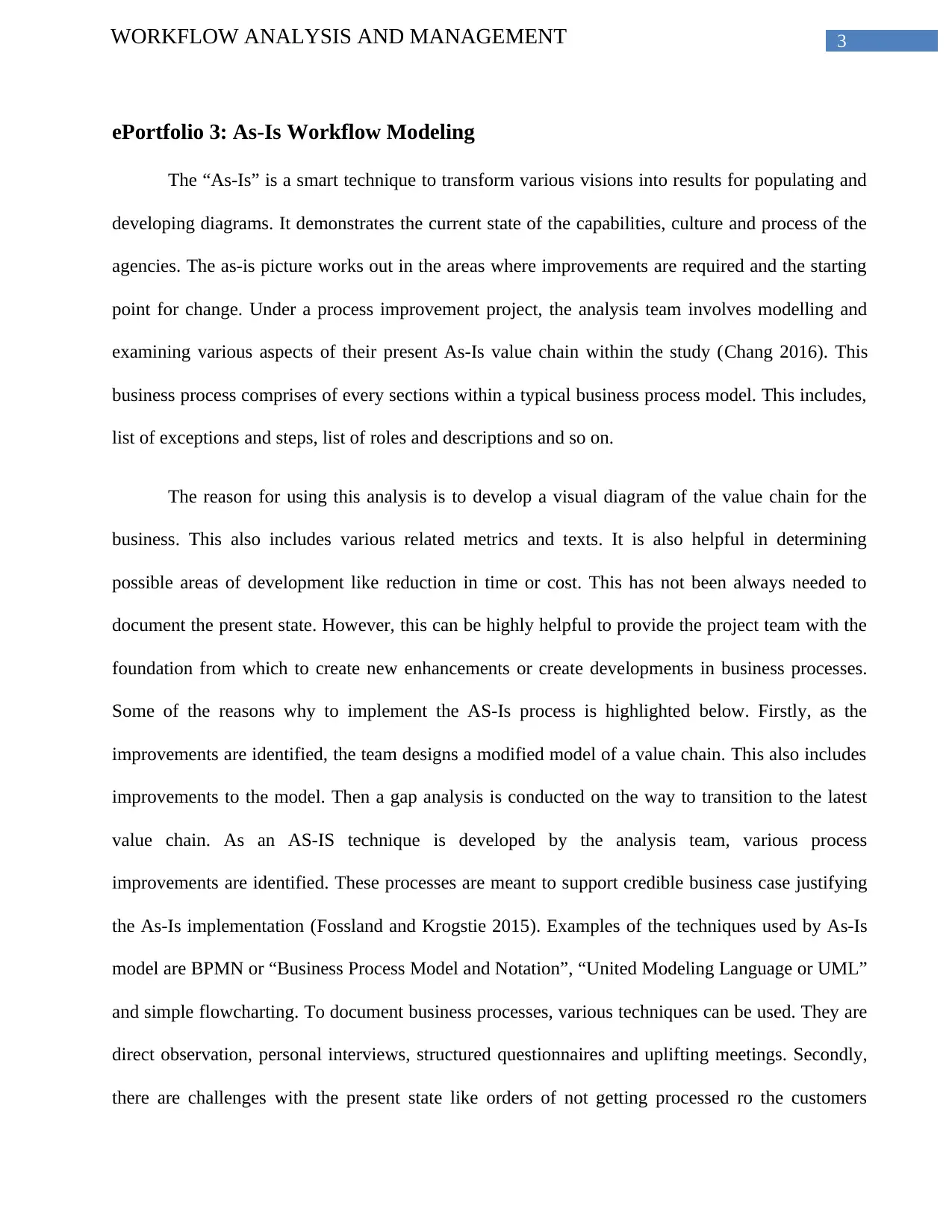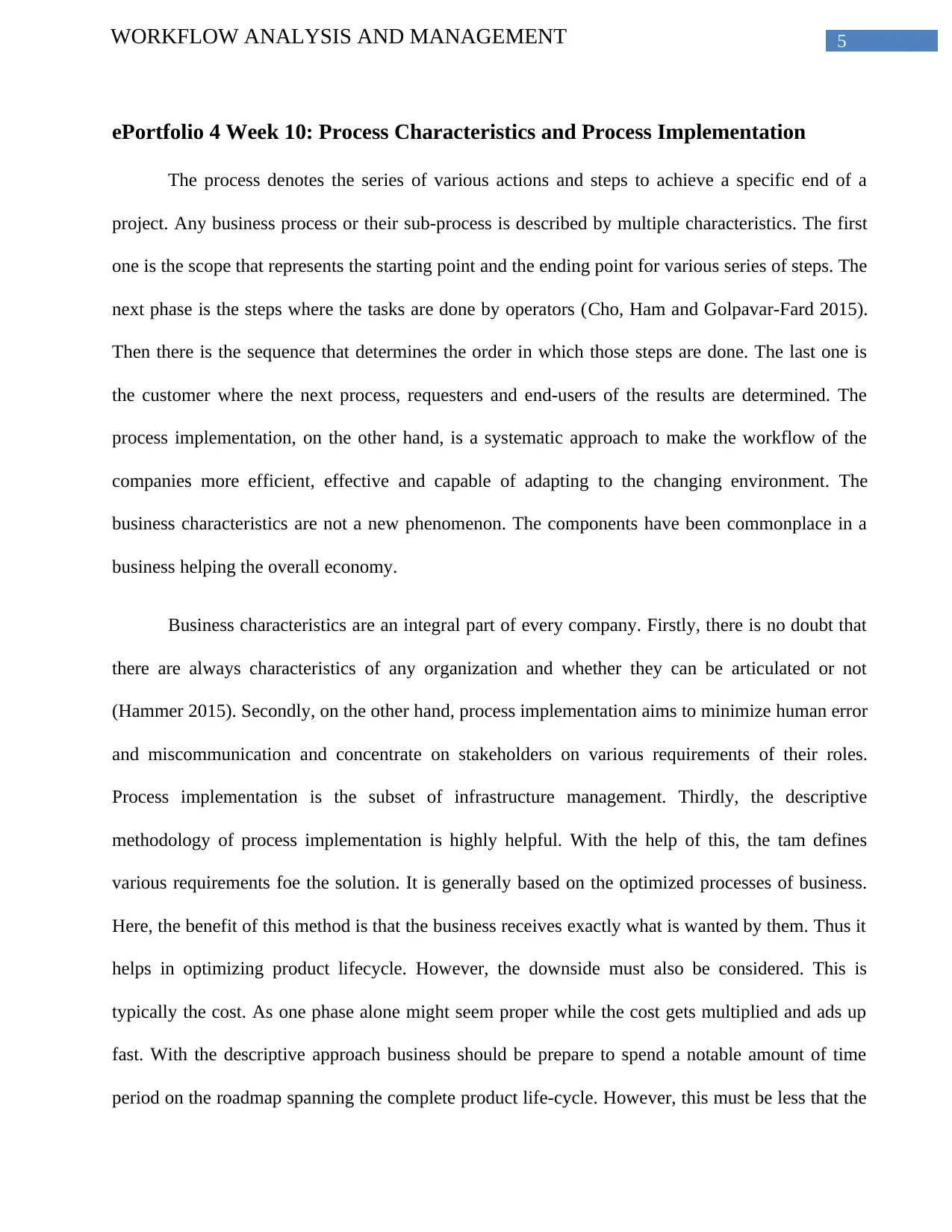Workflow Analysis and Management Report - University Name
VerifiedAdded on 2021/04/21
|7
|1910
|42
Report
AI Summary
This report provides a comprehensive overview of workflow analysis and management, focusing on business process technologies, as-is workflow modeling, process characteristics, and implementation strategies. It begins by defining business process management and its importance in improving corporate performance through optimized business processes. The report explores the application of business process technology, highlighting its role in understanding client demands, mastering present scenarios, and ensuring flexibility. Furthermore, it delves into as-is workflow modeling, explaining its purpose in visualizing current capabilities and identifying areas for improvement. The report discusses the characteristics of processes, including scope, steps, sequence, and customer, and examines different process implementation methodologies, such as descriptive and prescriptive approaches. Finally, the report references academic sources to support its analysis, providing a well-rounded understanding of the subject.

Running head: WORKFLOW ANALYSIS AND MANAGEMENT
Workflow Analysis and Management
Name of the student:
Name of the university:
Author Note
Workflow Analysis and Management
Name of the student:
Name of the university:
Author Note
Paraphrase This Document
Need a fresh take? Get an instant paraphrase of this document with our AI Paraphraser

1WORKFLOW ANALYSIS AND MANAGEMENT
ePortfolio 2: Business Process Technologies
Business process management is the area of operation management, focusing on the
development. This is to improve corporate performance through optimizing and managing business
process of companies. The method, in which BPM solution gets supported, implemented and
architected, is amplified through various outcomes. It is achieved through all of its components as
appropriately done. In an ideal condition, business process technologies are fused in such a way that
it delivers functionality and high flexibility accommodating business growth and modifications in
operations (Van Der Aalst, La Rosa and Santoro 2016). Thus the outcome provides rise on visibility
to business operations, an array of metrics top measure development, a gain of productivity through
automation, more smartly defined responsibilities of staffs and enhanced customer engagement.
The reason for the practical application of Business Process Technology is to wield the
expertise and insights of business. Firstly, this intends to understand the current demands of the
clients completely. This also includes understanding the current operations, challenges and future
state desired. It is helpful to compare the necessities of other clients and call on various extensive
experiences to design the optimal solution (Harmon 2015). Secondly, the central aspect to master
business process technology is the key. Besides, it can be applied efficiently to achieve the present
scenario. Moreover, many researchers have seen the business process technology as the ways to
reach the ending. It also deals with recognizing and capitalizing the key roles to craft ideal solutions
for business process management. Apart from this business process technology has been applicable
for flattering process definition. The processes require being for simple, modular and changeable.
This also includes simplification of user interface. Complexity is needed to be removed (Pflaum et
al. 2017). Users here require listing all the tracks for performing the task on daily basis and list the
various follow up activities. Business requires using mobile and other alternatives massively. It also
ePortfolio 2: Business Process Technologies
Business process management is the area of operation management, focusing on the
development. This is to improve corporate performance through optimizing and managing business
process of companies. The method, in which BPM solution gets supported, implemented and
architected, is amplified through various outcomes. It is achieved through all of its components as
appropriately done. In an ideal condition, business process technologies are fused in such a way that
it delivers functionality and high flexibility accommodating business growth and modifications in
operations (Van Der Aalst, La Rosa and Santoro 2016). Thus the outcome provides rise on visibility
to business operations, an array of metrics top measure development, a gain of productivity through
automation, more smartly defined responsibilities of staffs and enhanced customer engagement.
The reason for the practical application of Business Process Technology is to wield the
expertise and insights of business. Firstly, this intends to understand the current demands of the
clients completely. This also includes understanding the current operations, challenges and future
state desired. It is helpful to compare the necessities of other clients and call on various extensive
experiences to design the optimal solution (Harmon 2015). Secondly, the central aspect to master
business process technology is the key. Besides, it can be applied efficiently to achieve the present
scenario. Moreover, many researchers have seen the business process technology as the ways to
reach the ending. It also deals with recognizing and capitalizing the key roles to craft ideal solutions
for business process management. Apart from this business process technology has been applicable
for flattering process definition. The processes require being for simple, modular and changeable.
This also includes simplification of user interface. Complexity is needed to be removed (Pflaum et
al. 2017). Users here require listing all the tracks for performing the task on daily basis and list the
various follow up activities. Business requires using mobile and other alternatives massively. It also

2WORKFLOW ANALYSIS AND MANAGEMENT
involves the collaboration tools allowing users for following up those processes. Lastly, the business
process technology is effective regarding flexibility and change. The changes have been coming very
fast. It must be reminded that organizational processes and lives have been very much dynamic.
Here, process implementation must be allowing managing those changes (Ham and Golparvar-Fard
2015). This must be a very easy-to-make step. Business must be able to re-assign the people, cancel
or modify tasks and change the overall process.
References:
Ham, Y. and Golparvar-Fard, M., 2015. Mapping actual thermal properties to building elements in
gbXML-based BIM for reliable building energy performance modeling. Automation in
Construction, 49, pp.214-224.
Harmon, P., 2015. The scope and evolution of business process management. In Handbook on
business process management 1 (pp. 37-80). Springer, Berlin, Heidelberg.
Pflaum, A., Bodendorf, F., Prockl, G. and Chen, H., 2017. Introduction to The Digital Supply Chain
of the Future: Technologies, Applications and Business Models Minitrack.
Van Der Aalst, W.M., La Rosa, M. and Santoro, F.M., 2016. Business process management.
vom Brocke, J., Zelt, S. and Schmiedel, T., 2016. On the role of context in business process
management. International Journal of Information Management, 36(3), pp.486-495.
involves the collaboration tools allowing users for following up those processes. Lastly, the business
process technology is effective regarding flexibility and change. The changes have been coming very
fast. It must be reminded that organizational processes and lives have been very much dynamic.
Here, process implementation must be allowing managing those changes (Ham and Golparvar-Fard
2015). This must be a very easy-to-make step. Business must be able to re-assign the people, cancel
or modify tasks and change the overall process.
References:
Ham, Y. and Golparvar-Fard, M., 2015. Mapping actual thermal properties to building elements in
gbXML-based BIM for reliable building energy performance modeling. Automation in
Construction, 49, pp.214-224.
Harmon, P., 2015. The scope and evolution of business process management. In Handbook on
business process management 1 (pp. 37-80). Springer, Berlin, Heidelberg.
Pflaum, A., Bodendorf, F., Prockl, G. and Chen, H., 2017. Introduction to The Digital Supply Chain
of the Future: Technologies, Applications and Business Models Minitrack.
Van Der Aalst, W.M., La Rosa, M. and Santoro, F.M., 2016. Business process management.
vom Brocke, J., Zelt, S. and Schmiedel, T., 2016. On the role of context in business process
management. International Journal of Information Management, 36(3), pp.486-495.
⊘ This is a preview!⊘
Do you want full access?
Subscribe today to unlock all pages.

Trusted by 1+ million students worldwide

3WORKFLOW ANALYSIS AND MANAGEMENT
ePortfolio 3: As-Is Workflow Modeling
The “As-Is” is a smart technique to transform various visions into results for populating and
developing diagrams. It demonstrates the current state of the capabilities, culture and process of the
agencies. The as-is picture works out in the areas where improvements are required and the starting
point for change. Under a process improvement project, the analysis team involves modelling and
examining various aspects of their present As-Is value chain within the study (Chang 2016). This
business process comprises of every sections within a typical business process model. This includes,
list of exceptions and steps, list of roles and descriptions and so on.
The reason for using this analysis is to develop a visual diagram of the value chain for the
business. This also includes various related metrics and texts. It is also helpful in determining
possible areas of development like reduction in time or cost. This has not been always needed to
document the present state. However, this can be highly helpful to provide the project team with the
foundation from which to create new enhancements or create developments in business processes.
Some of the reasons why to implement the AS-Is process is highlighted below. Firstly, as the
improvements are identified, the team designs a modified model of a value chain. This also includes
improvements to the model. Then a gap analysis is conducted on the way to transition to the latest
value chain. As an AS-IS technique is developed by the analysis team, various process
improvements are identified. These processes are meant to support credible business case justifying
the As-Is implementation (Fossland and Krogstie 2015). Examples of the techniques used by As-Is
model are BPMN or “Business Process Model and Notation”, “United Modeling Language or UML”
and simple flowcharting. To document business processes, various techniques can be used. They are
direct observation, personal interviews, structured questionnaires and uplifting meetings. Secondly,
there are challenges with the present state like orders of not getting processed ro the customers
ePortfolio 3: As-Is Workflow Modeling
The “As-Is” is a smart technique to transform various visions into results for populating and
developing diagrams. It demonstrates the current state of the capabilities, culture and process of the
agencies. The as-is picture works out in the areas where improvements are required and the starting
point for change. Under a process improvement project, the analysis team involves modelling and
examining various aspects of their present As-Is value chain within the study (Chang 2016). This
business process comprises of every sections within a typical business process model. This includes,
list of exceptions and steps, list of roles and descriptions and so on.
The reason for using this analysis is to develop a visual diagram of the value chain for the
business. This also includes various related metrics and texts. It is also helpful in determining
possible areas of development like reduction in time or cost. This has not been always needed to
document the present state. However, this can be highly helpful to provide the project team with the
foundation from which to create new enhancements or create developments in business processes.
Some of the reasons why to implement the AS-Is process is highlighted below. Firstly, as the
improvements are identified, the team designs a modified model of a value chain. This also includes
improvements to the model. Then a gap analysis is conducted on the way to transition to the latest
value chain. As an AS-IS technique is developed by the analysis team, various process
improvements are identified. These processes are meant to support credible business case justifying
the As-Is implementation (Fossland and Krogstie 2015). Examples of the techniques used by As-Is
model are BPMN or “Business Process Model and Notation”, “United Modeling Language or UML”
and simple flowcharting. To document business processes, various techniques can be used. They are
direct observation, personal interviews, structured questionnaires and uplifting meetings. Secondly,
there are challenges with the present state like orders of not getting processed ro the customers
Paraphrase This Document
Need a fresh take? Get an instant paraphrase of this document with our AI Paraphraser

4WORKFLOW ANALYSIS AND MANAGEMENT
getting frustrated to the level of service of the organization. Thirdly, the businesses need to
streamline or automate the present processes. However, this current stake is never understood well or
got documented. Fourthly, it must be understood that bringing the stakeholders together, or assessing
the present scenario his not helpful much. The clarity originates from effective business process
documentation. At many times it resolves confusions and fulfills gaps causing challenges.
References:
Chang, J.F., 2016. Business process management systems: strategy and implementation. CRC Press.
Fossland, S. and Krogstie, J., 2015, November. Modeling As-is, Ought-to-be and To-be-Experiences
from a Case study in the Health Sector. In PoEM (Short Papers) (pp. 11-20).
getting frustrated to the level of service of the organization. Thirdly, the businesses need to
streamline or automate the present processes. However, this current stake is never understood well or
got documented. Fourthly, it must be understood that bringing the stakeholders together, or assessing
the present scenario his not helpful much. The clarity originates from effective business process
documentation. At many times it resolves confusions and fulfills gaps causing challenges.
References:
Chang, J.F., 2016. Business process management systems: strategy and implementation. CRC Press.
Fossland, S. and Krogstie, J., 2015, November. Modeling As-is, Ought-to-be and To-be-Experiences
from a Case study in the Health Sector. In PoEM (Short Papers) (pp. 11-20).

5WORKFLOW ANALYSIS AND MANAGEMENT
ePortfolio 4 Week 10: Process Characteristics and Process Implementation
The process denotes the series of various actions and steps to achieve a specific end of a
project. Any business process or their sub-process is described by multiple characteristics. The first
one is the scope that represents the starting point and the ending point for various series of steps. The
next phase is the steps where the tasks are done by operators (Cho, Ham and Golpavar-Fard 2015).
Then there is the sequence that determines the order in which those steps are done. The last one is
the customer where the next process, requesters and end-users of the results are determined. The
process implementation, on the other hand, is a systematic approach to make the workflow of the
companies more efficient, effective and capable of adapting to the changing environment. The
business characteristics are not a new phenomenon. The components have been commonplace in a
business helping the overall economy.
Business characteristics are an integral part of every company. Firstly, there is no doubt that
there are always characteristics of any organization and whether they can be articulated or not
(Hammer 2015). Secondly, on the other hand, process implementation aims to minimize human error
and miscommunication and concentrate on stakeholders on various requirements of their roles.
Process implementation is the subset of infrastructure management. Thirdly, the descriptive
methodology of process implementation is highly helpful. With the help of this, the tam defines
various requirements foe the solution. It is generally based on the optimized processes of business.
Here, the benefit of this method is that the business receives exactly what is wanted by them. Thus it
helps in optimizing product lifecycle. However, the downside must also be considered. This is
typically the cost. As one phase alone might seem proper while the cost gets multiplied and ads up
fast. With the descriptive approach business should be prepare to spend a notable amount of time
period on the roadmap spanning the complete product life-cycle. However, this must be less that the
ePortfolio 4 Week 10: Process Characteristics and Process Implementation
The process denotes the series of various actions and steps to achieve a specific end of a
project. Any business process or their sub-process is described by multiple characteristics. The first
one is the scope that represents the starting point and the ending point for various series of steps. The
next phase is the steps where the tasks are done by operators (Cho, Ham and Golpavar-Fard 2015).
Then there is the sequence that determines the order in which those steps are done. The last one is
the customer where the next process, requesters and end-users of the results are determined. The
process implementation, on the other hand, is a systematic approach to make the workflow of the
companies more efficient, effective and capable of adapting to the changing environment. The
business characteristics are not a new phenomenon. The components have been commonplace in a
business helping the overall economy.
Business characteristics are an integral part of every company. Firstly, there is no doubt that
there are always characteristics of any organization and whether they can be articulated or not
(Hammer 2015). Secondly, on the other hand, process implementation aims to minimize human error
and miscommunication and concentrate on stakeholders on various requirements of their roles.
Process implementation is the subset of infrastructure management. Thirdly, the descriptive
methodology of process implementation is highly helpful. With the help of this, the tam defines
various requirements foe the solution. It is generally based on the optimized processes of business.
Here, the benefit of this method is that the business receives exactly what is wanted by them. Thus it
helps in optimizing product lifecycle. However, the downside must also be considered. This is
typically the cost. As one phase alone might seem proper while the cost gets multiplied and ads up
fast. With the descriptive approach business should be prepare to spend a notable amount of time
period on the roadmap spanning the complete product life-cycle. However, this must be less that the
⊘ This is a preview!⊘
Do you want full access?
Subscribe today to unlock all pages.

Trusted by 1+ million students worldwide

6WORKFLOW ANALYSIS AND MANAGEMENT
implementation of ERP. It has not been bad necessarily as long as business proves that project
methodologies rings more money at every step. Further, it provides more value to business than the
costs (vom Brocke, Zelt and Schmiedel 2016). Lastly, the prescriptive methodology can also be
implemented. With the help of this method, one can lean completely to the vendors and implement
partners for bringing the leading practicing approaches for particular industries. It must be noted that
it has not been the similar thing like the out-of-box case. This should be grounded on various leading
practices like one expects. Further, with this approach, the project team provides the primary setup
information that has been unique to the business like users and list of sites (Möller and Parvinen
2015). However, there are no issues in data structures, business process or functionality. As done
well the approach is very fast to implement and costs the fraction of that price.
References:
Cho, Y.K., Ham, Y. and Golpavar-Fard, M., 2015. 3D as-is building energy modeling and
diagnostics: A review of the state-of-the-art. Advanced Engineering Informatics, 29(2), pp.184-195.
Hammer, M., 2015. What is business process management?. In Handbook on Business Process
Management 1 (pp. 3-16). Springer, Berlin, Heidelberg.
Harmon, P., 2015. The scope and evolution of business process management. In Handbook on
business process management 1 (pp. 37-80). Springer, Berlin, Heidelberg.
Möller, K. and Parvinen, P., 2015. An impact-oriented implementation approach in business
marketing research: Introduction to the Special Issue on “Implementing Strategies and Theories of
B2B Marketing and Sales Management”. Industrial Marketing Management, 45, pp.3-11.
vom Brocke, J., Zelt, S. and Schmiedel, T., 2016. On the role of context in business process
management. International Journal of Information Management, 36(3), pp.486-495.
implementation of ERP. It has not been bad necessarily as long as business proves that project
methodologies rings more money at every step. Further, it provides more value to business than the
costs (vom Brocke, Zelt and Schmiedel 2016). Lastly, the prescriptive methodology can also be
implemented. With the help of this method, one can lean completely to the vendors and implement
partners for bringing the leading practicing approaches for particular industries. It must be noted that
it has not been the similar thing like the out-of-box case. This should be grounded on various leading
practices like one expects. Further, with this approach, the project team provides the primary setup
information that has been unique to the business like users and list of sites (Möller and Parvinen
2015). However, there are no issues in data structures, business process or functionality. As done
well the approach is very fast to implement and costs the fraction of that price.
References:
Cho, Y.K., Ham, Y. and Golpavar-Fard, M., 2015. 3D as-is building energy modeling and
diagnostics: A review of the state-of-the-art. Advanced Engineering Informatics, 29(2), pp.184-195.
Hammer, M., 2015. What is business process management?. In Handbook on Business Process
Management 1 (pp. 3-16). Springer, Berlin, Heidelberg.
Harmon, P., 2015. The scope and evolution of business process management. In Handbook on
business process management 1 (pp. 37-80). Springer, Berlin, Heidelberg.
Möller, K. and Parvinen, P., 2015. An impact-oriented implementation approach in business
marketing research: Introduction to the Special Issue on “Implementing Strategies and Theories of
B2B Marketing and Sales Management”. Industrial Marketing Management, 45, pp.3-11.
vom Brocke, J., Zelt, S. and Schmiedel, T., 2016. On the role of context in business process
management. International Journal of Information Management, 36(3), pp.486-495.
1 out of 7
Related Documents
Your All-in-One AI-Powered Toolkit for Academic Success.
+13062052269
info@desklib.com
Available 24*7 on WhatsApp / Email
![[object Object]](/_next/static/media/star-bottom.7253800d.svg)
Unlock your academic potential
Copyright © 2020–2025 A2Z Services. All Rights Reserved. Developed and managed by ZUCOL.





